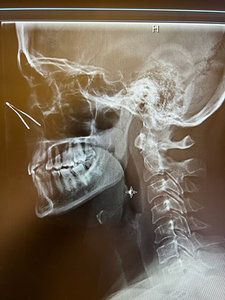Editor's Note: With this article, Dr. Miller adds another installment to his periodic "Dynamic Diagnosis" series: concise anecdotes that serve as clinical pearls for your practice.
A 36-year-old female with fibromyalgia sought chiropractic care for neck pain in January 2022.
History, examination, and a three-view radiographic study of the cervical spine were performed. The combination of diagnostic procedures was unremarkable, other than an increase in the severity of existing trigger points in the cervical and shoulder regions.
A new diagnosis was not assigned, and the patient received care for an acute exacerbation of her chronic fibromyalgia condition. Care proceeded successfully in a routine manner.
An Interesting Radiological Feature
While the case was unremarkable clinically, it provided an interesting radiological feature. An artifact was present on the lateral radiograph. The artifact was not visible on the AP or APOM radiographs, as positioning for those images is lower, more caudal, than for the lateral view.
 A radiation technologist performed the imaging, and the radiologist did not mention the artifact in his report. The attending physician caring for the patient noticed the artifact.
A radiation technologist performed the imaging, and the radiologist did not mention the artifact in his report. The attending physician caring for the patient noticed the artifact.
When the attending noticed the artifact, he immediately realized it is not typically seen in radiology textbooks covering common and unusual artifacts, nor had the attending noticed it in the past.
Three Different Opinions
Once the artifact was identified, the attending wondered if other physicians would recognize the artifact and the reason for its presence. So, he asked three physicians to identify the artifact.
The first physician remarked that the artifact was the nose piece of the patient's glasses. However, the patient was not wearing glasses. The second physician said the artifact was probably associated with a rhinoplasty procedure. However, the patient had not had a nose job.
The third physician's first guess was that the patient had something stuck in her nose, but he quickly changed course to identify the artifact correctly.
The Correct Answer
The artifact was the metal in the nose area of the N-95 mask the patient wore during the radiographic procedure (See X-ray) – a "sign of the times."
Click here for more information about K. Jeffrey Miller, DC, MBA.





